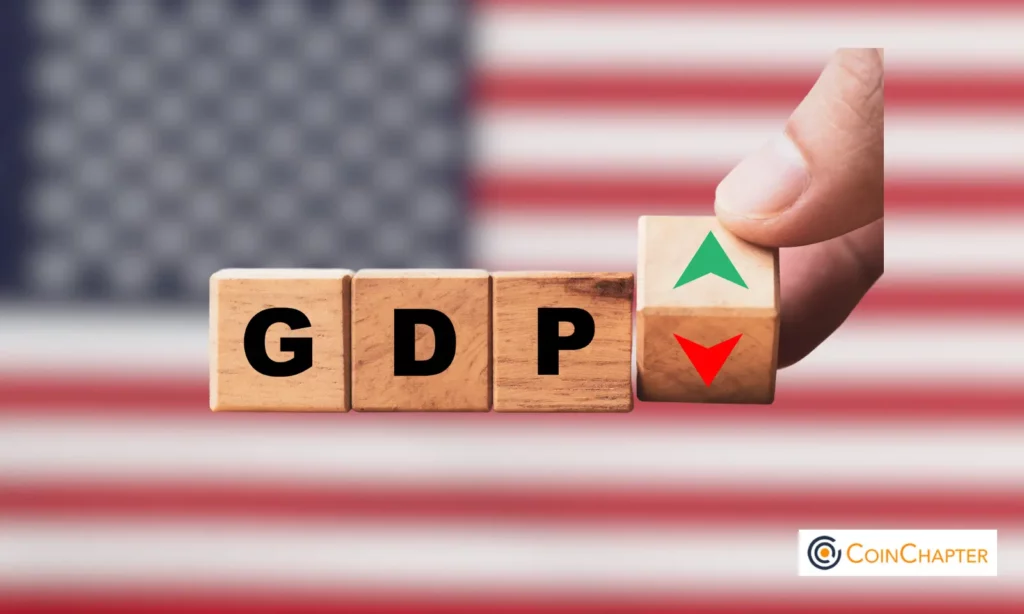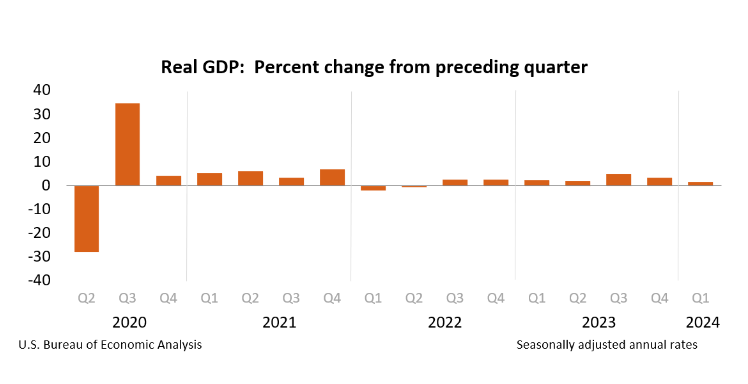Key Takeaways:
- US GDP growth slows due to high interest rates and inflation pressures.
- Consumer spending and housing market show significant signs of deceleration.
- Business investment and trade falter, while labor market begins to cool.

LUCKNOW (CoinChapter.com) — The United States economy is showing clear signs of deceleration as it grapples with the Federal Reserve’s persistent high-interest rate policy and stubborn inflation. Recent economic indicators reveal a significant downshift in U.S. GDP growth during the first half of 2024.
Bill Adams, chief economist at Comerica Bank, summarized the situation:
The economy is operating in low gear in the first half of 2024 after above-trend growth in the second half of 2023. Real GDP was cool in the first quarter, and the second quarter has seen continued softness in retail sales and housing activity.

The Atlanta Fed’s GDPNow forecast has revised its second-quarter growth projection from 3% to 2.7%.

Consumer Spending and Housing Market Show Strain
Personal spending, the primary driver of US GDP, slowed down in the first quarter of 2024. Initial estimates of 2% growth were revised downward to just 1.5%, signaling a concerning trend for the economy’s main engine.
You Might Also Like: US GDP Plunges Amid Inflation Spike—Is a Recession Looming in 2024?
The housing sector is particularly vulnerable to high interest rates, with mortgage rates hovering around 7%. The National Association of Realtors reported that contract signings for previously owned homes have plummeted to their lowest levels since 2001.
The latest economic indicators reveal additional challenges for US GDP growth. Core capital goods shipments, a crucial component in calculating equipment investment for GDP reports, fell by 0.5% – the largest decrease in three months. This decline suggests a potential drag on overall GDP figures.
Furthermore, domestic producers are grappling with a stronger U.S. dollar, which has been climbing throughout 2024 due to expectations of prolonged high interest rates. This currency appreciation poses a significant risk to export demand, potentially weakening a key contributor to GDP growth.
Labor Market Cools, Inventory Buildup Offers Some Relief
While the job market has been a bright spot in the economy, recent data suggests it may lose some of its luster. Continuing jobless claims have climbed to their highest level since 2021.
However, it’s not all negative news for US GDP projections. The same report indicated increases in inventories at both wholesale and retail levels. This buildup in inventories could help offset some of the negative impact on second-quarter GDP stemming from the widening trade deficit.
Business Investment and Trade Falter
Businesses are also feeling the strain of elevated borrowing costs. Core capital goods orders, a key indicator of business investment, showed one of the largest drops 2024. Additionally, the strengthening U.S. dollar has widened the merchandise trade gap to $100.6 billion in May, potentially putting pressure on US GDP growth.
As the Federal Reserve maintains its high-interest rate policy to combat inflation, the U.S. economy faces continued headwinds. The moderation in economic activity is expected to dampen inflation further but at the cost of slower US GDP growth.
You Might Also Like: Traders Anticipate 50 Basis Points Fed Rate Cuts by 2024 End
While a moderate rebound in personal spending is projected for May, signs of financial strain suggest cooler growth in the coming months.


